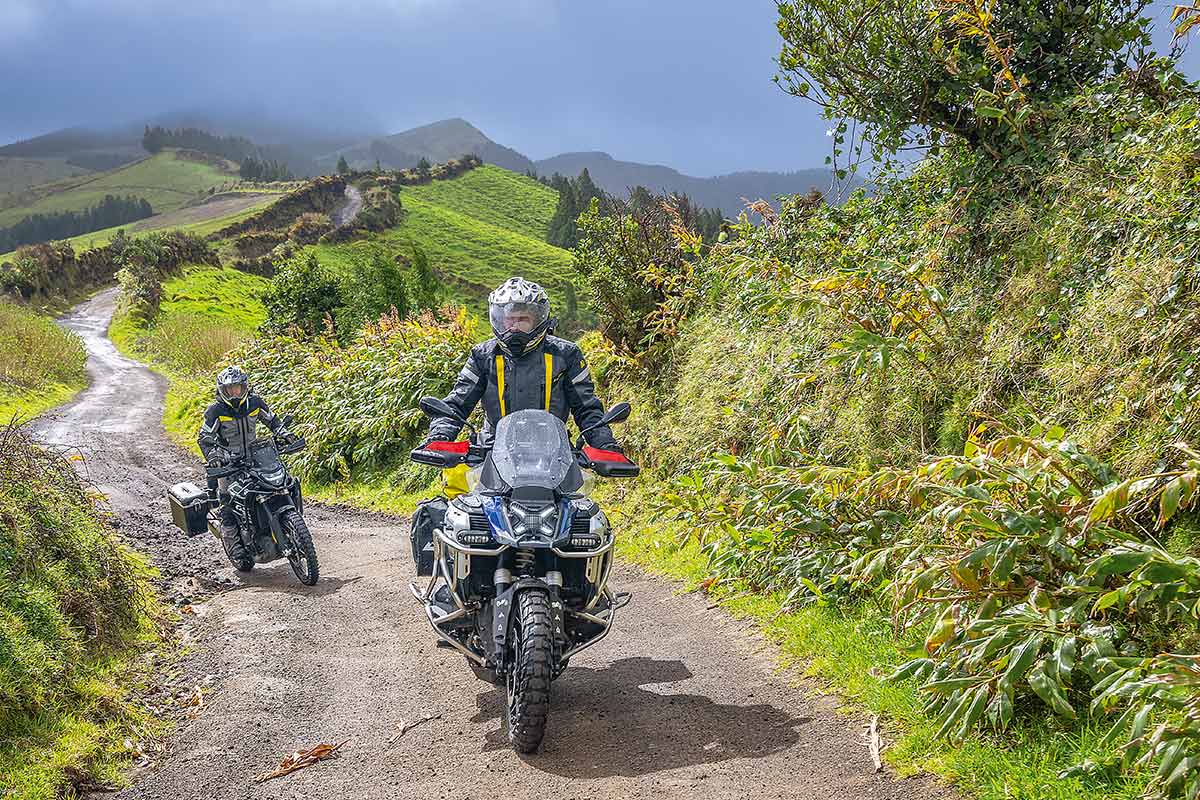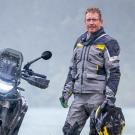The Azores lie windswept in the middle of the Atlantic. Spectacular routes, unique landscapes and a relaxed atmosphere make the archipelago an exceptional destination for motorcyclists.
Like probably thousands of other motorbike enthusiasts, I had met Charley Boorman occasionally over the years at motorbike shows and events. But of course, we didn't really know each other through that. So it was a dream come true when Touratech brought me and Charley together to explore the Azores on motorbikes. I was finally able to go on tour with the person who had done so much for the adventure scene.
It was a surreal experience when I heard Charley's voice in my headphones for the first time. It sounded so familiar, a voice I've heard hundreds of times over the last 20 years watching his TV programmes. We just chat away as I follow him along the narrow streets of Ponta Delgada towards the north coast.

Grove of towering trees with mysterious orange-coloured bark.
“EUROPE’S HAWAII“
The Azores are known as “Europe’s Hawaii”, but in reality, the climate of the archipelago is more temperate than that of Hawaii, with an average temperature of less than 16 degrees in winter and a warm 21 degrees in summer. On the other hand, the rainfall is similarly high and the lush greenery is indeed reminiscent of Hawaii. There is no shortage of wind either!
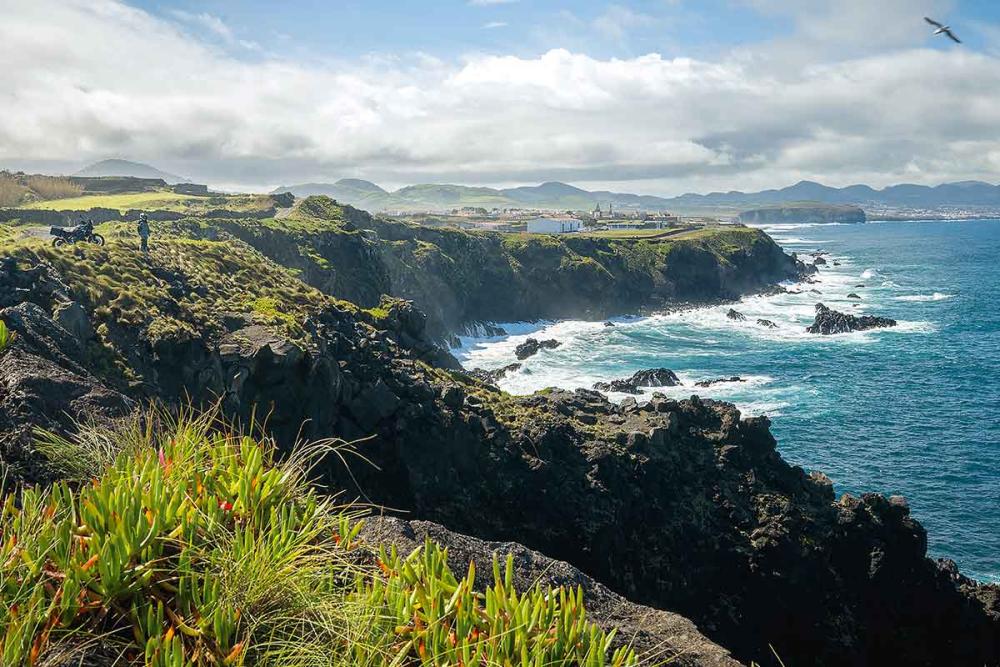
Breath-taking view of the Atlantic Ocean on the north coast near Ponta Delgada.
Our trip takes place in the second week of March, and Mother Nature impressively reminds us that it can get quite uncomfortable on the islands. Luckily for us, we have the very latest Touratech riding kit with us, which is perfect for a wild ride in unpredictable and extreme weather. Charlie is wearing the Compañero Worldtrack, and I'm wearing the Compañero Rambler 2. Even in temperatures of around plus four degrees Celsius and heavy rain, the suits keep us comfortable.
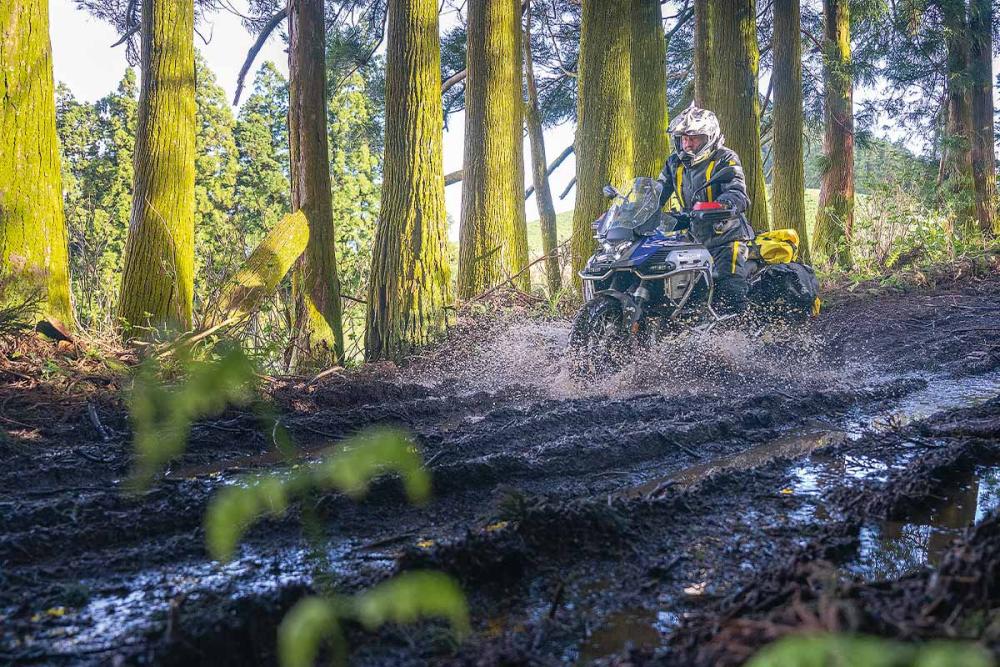
Charley playing in the mud on his BMW R 1300 GS Adventure.
CHARLEY'S GS LOSES THE BATTLE WITH THE SCREE
The roads are a perfect combination of winding paths through breathtaking, lush green landscapes. Again and again we are presented with views of the deep blue sea with foaming white waves thundering against black volcanic rocks. Away from the coast, we wind our way along remote gravel roads and dirt tracks through forest reserves up to the highest mountain peaks.
The island of Saõ Miguel is nothing more than a huge, active volcano, and the terrain is a direct result of this. The black and reddish gravel is of volcanic origin and generally offers confidence-inspiring traction. In some places, however, the gravel has grain sizes that are more akin to golf balls. Charley's R 1300 GS Adventure loses a battle with the gravel in a bend. But the crash bars do their job and, after a short moment of shock, we can continue.
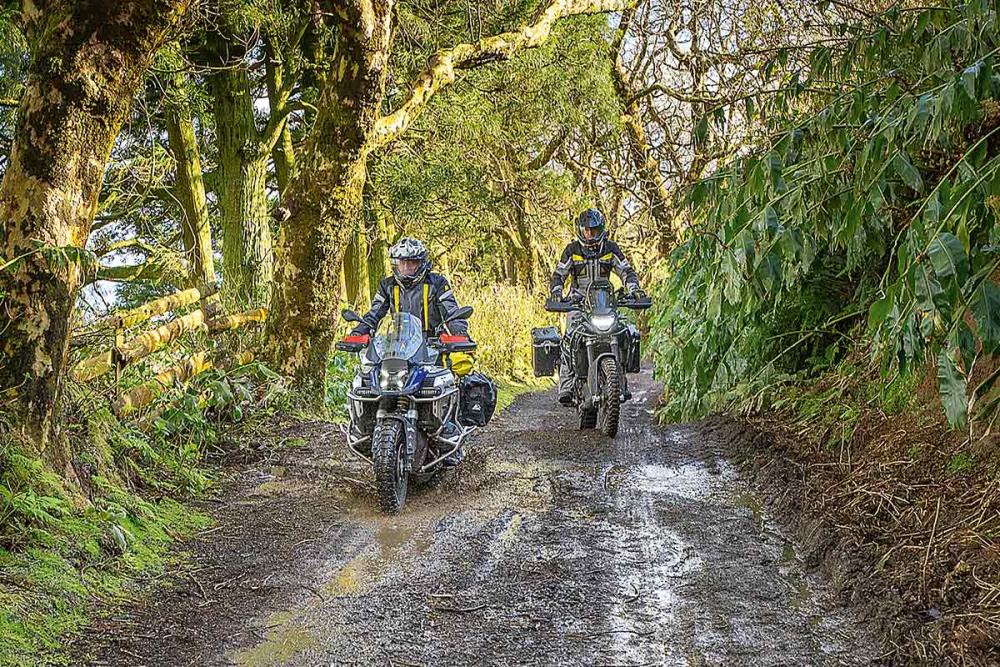
We work our way through the muddy chaos on the side roads.
The island also has flat, levelled gravel roads made of volcanic ash, which are great fun - but only until they get wet. When a gust of wind snatches the handlebars out of nowhere, which is often the case here, you can feel how slippery the surface is. It feels like riding on a greased pan. A shallow rut that I have overlooked takes me off course and I end up on a collision course with a rock face. I can't catch the bike in time and crash my bike and helmet into a wall of black volcanic rock. My Aventuro Carbon Pro protects me, I'm not injured. But the ‘tower’, which supports the windscreen and the instrument cluster, is broken. We get out the tool set and stabilise the mount with cable ties and wire so that we can carefully continue our journey.

Countless waterfalls all over the island invite you to marvel.
EMERALD GREEN WATER RIPPLES AT THE FOOT OF THE VERTICAL WALL
The rough gravel road that follows a mountain ridge and circles Sete Cidades, which is the island's most famous caldera, offers us unique views. To our right, we have a breathtaking view of the Atlantic Ocean with its windswept waves and spray that flies metre-high. To our left is an almost vertical slope with short green vegetation that looks almost like a corrugated crisp with its undulating structure. At the foot of the green wall are the emerald green waters of Lagoa Azul (Blue Lake) and Lagoa Verde (Green Lake). This is the place you see on the travel websites, and we now understand why. The dramatic landscape is overwhelming when you see it with your own eyes. The caldera is the result of a collapsed magma chamber from the geological past.
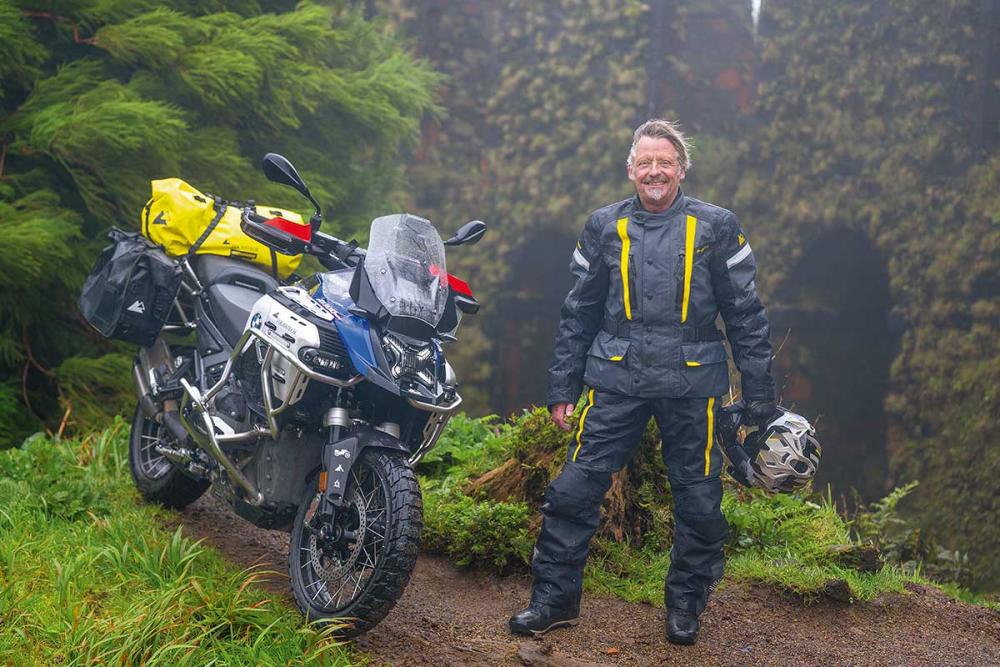
Having a good laugh: The Compañero keeps Charley warm and dry.
There are several calderas on the island, but this one is particularly impressive due to its enormous size and the fact that it is perfectly framed by the sea on three sides. We meet up with a local geologist who has been researching the volcanoes of the Azores for almost 40 years. As we stand with him high up on a viewpoint on Pico do Ferro, he points to several calderas and explains how the landscapes and geothermal processes have been shaped over time by volcanic activity. He explains that the earthquake we woke up to the other morning had a magnitude of 5.2 and was about 30 kilometres away from where we were. Earthquakes are taken very seriously here as there have been tragedies in the past. The most notable of these occurred in 1522, when the mudslide caused by an earthquake buried an estimated 5,000 inhabitants. We say goodbye with a queasy feeling, as the geologist reminds us that we are on an active volcano that could erupt at any time.
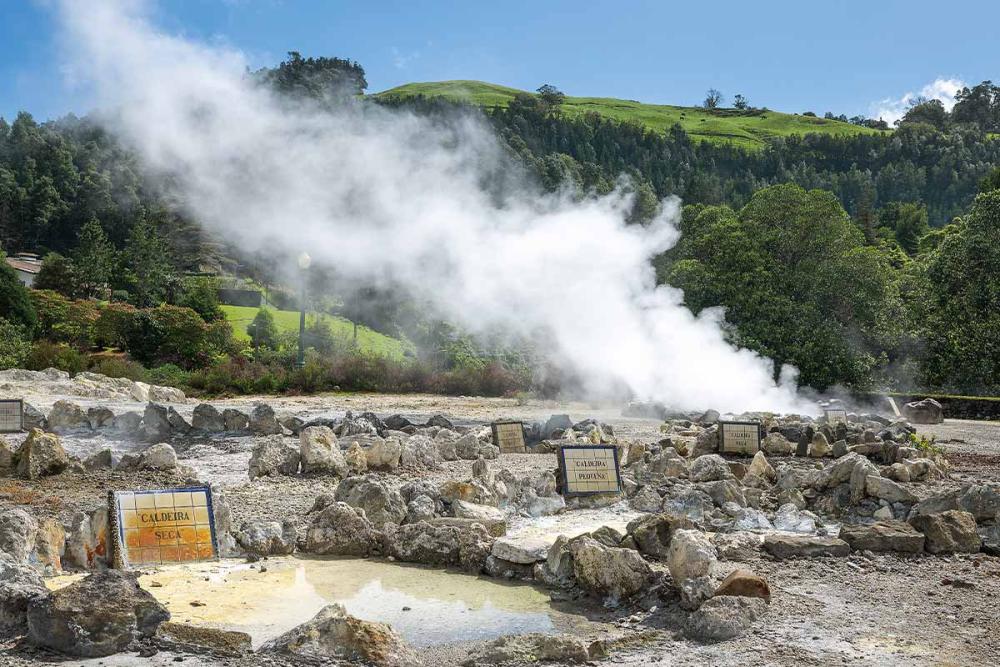
Living geology: the whole island is an active volcano.
A BEAUTIFUL COUNTRY LIFE
There are numerous sleepy villages by the sea on Saõ Miguel. The houses have whitewashed walls and red-tiled roofs. As we roll leisurely through the hamlets, we can literally feel the peace and quiet. Time seems to stand still here. Island life in its purest form. The locals are relaxed and have a gentle charisma. Just like the dairy cows they look after.

The author listens to the stories of the teashop owner.
Even in the capital, Ponta Delgada, things are easy-going. The people we deal with are pleasant and friendly. You feel very safe and welcome. The culinary delights of the Azores will delight even the most discerning palate. The seafood is as fresh as it can be, thanks to the fishing that is still practised today; the cheese is award-winning and the meat from the Ramo Grande cattle, native to the Azores for 500 years, is the highlight of our culinary experience.
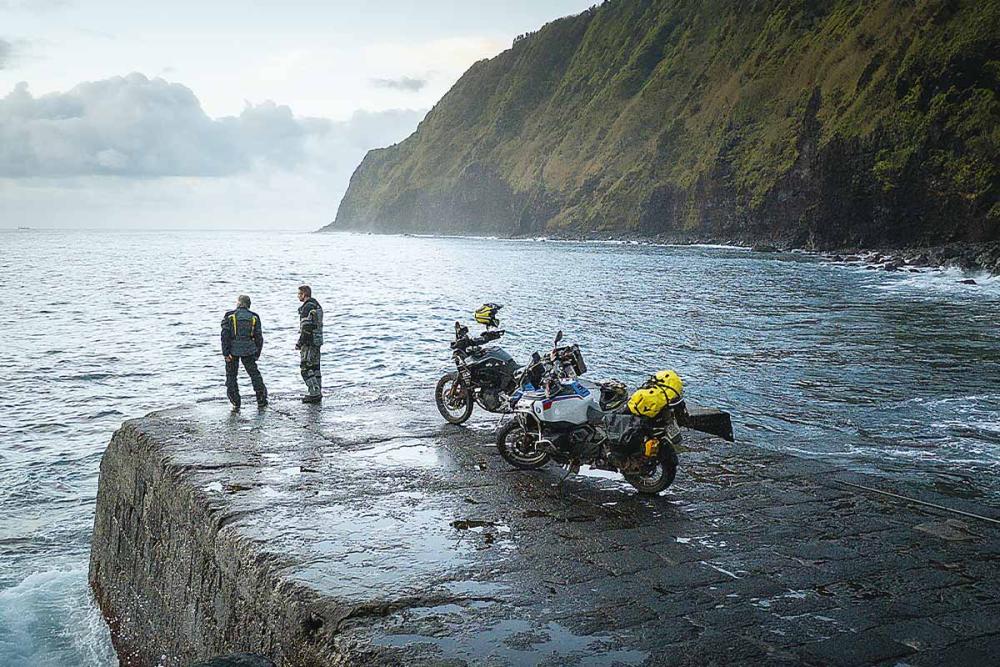
After an arduous descent from the Arnel lighthouse, we reach this perfect ‘car park’ by the sea.
We see more dairy cows than people as we explore the island. Outside the main town of Ponta Delgada, most of the men wear knee-high wellies. A clear sign that they are working on the wet and muddy pastures of a dairy farm. Most of the farms are small family businesses with 20 to 100 Holstein-Friesian dairy cows. We don't see large barns as most cows are milked with mobile machines that allow the animals to stay out in the pastures. The cows are fed almost exclusively on pasture, which is not common in most parts of the world. The quality of life for the cows is quite good by dairy farming standards. Pastures make up around 40 per cent of the area of Saõ Miguel.
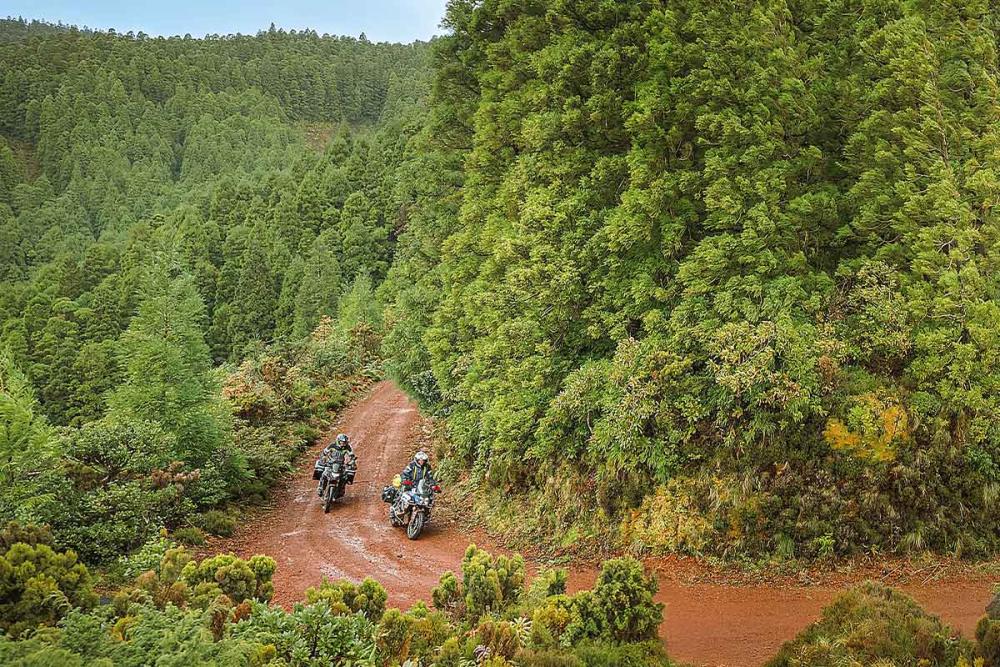
The mountains of Saõ Miguel offer incredibly beautiful forest paths with hardly any other people around.
We see stunning seafront properties with views where in another part of the world you would expect to find luxury flats or golf courses. Here, the most marvellous landscapes with sea views are not for the rich and famous. They are reserved for the black and white spotted dairy cows. These gentle giants live in the idyllic cow paradise and are the heart and soul of Saõ Miguel.
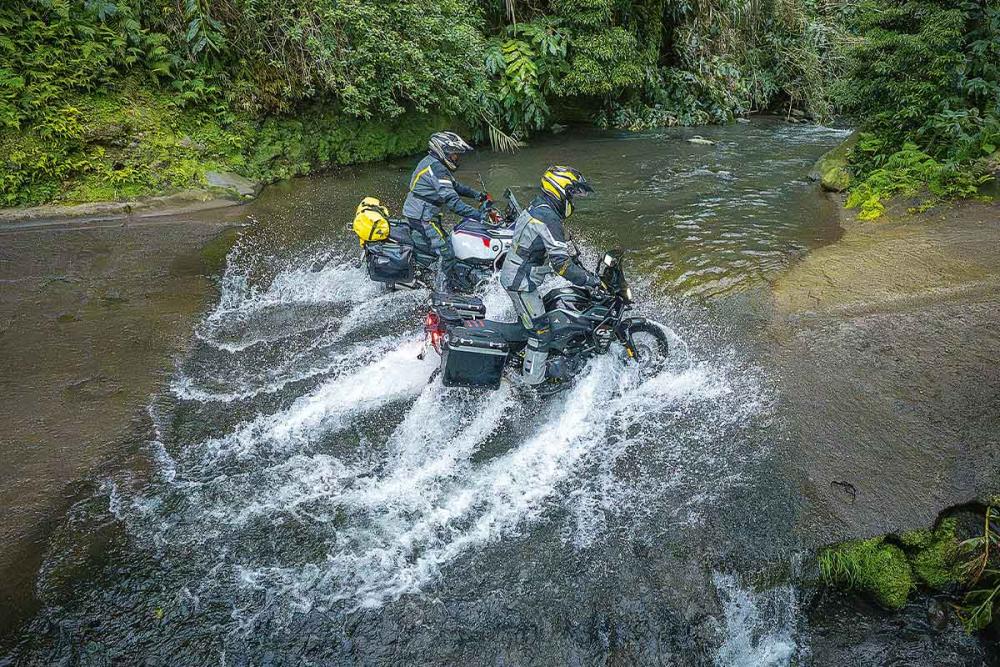
Not so rare: Water crossings with a strong current.
FOUR SEASONS IN ONE HOUR
The island is completely exposed to the wildness of the Atlantic, and a storm is raging this week. We drive through rain showers fuelled by gale-force winds. We fight against the wind as we drive up a narrow, unpaved, two-lane road to the viewpoint at Pico da Cruz. We park the motorbikes and lean against the wind with our arms outstretched as the gusts bear the weight of our bodies. When we return to our bikes, we are shocked to realise that the wind has caused them to fall.

In the wet conditions, there were plenty of opportunities for teamwork.
A short time later, as we turn a corner, we find a fellow motorcyclist in distress. He is waving wildly to attract our attention as he lies on the ground with his motorbike. I crouch down, grab the rear wheel with both hands and lift the rear of his motorbike to free his right leg, which was trapped under the swingarm. He tells me that he has been blown over by a gust of wind and has been lying there helpless for a few minutes.
We experience incredible contrasts in the Azores. While an icy wind blows around our ears from the high vantage points at almost five degrees Celsius, just half an hour later we are having lunch in the sunshine in a picturesque coastal village. Charley summarises it best when he says that we experience four seasons in one hour in the Azores. Although we didn't get to enjoy the typical mild weather, we fully savoured the power of the Atlantic Ocean and experienced the wild side of the Azores. We felt alive there and will not soon forget the intense impressions. As for driving with Charley, he is exactly the same guy in person as he is on TV. I really enjoyed his quick wit, his British humour and his desire to explore on two wheels.
CHARLEY BOORMAN
There are few people who have influenced the motorbike travel scene as much as Charley Boorman. The television series he created with Ewan McGregor around 20 years ago was instrumental in bringing the largely unknown niche of motorbike adventure travel into the mainstream consciousness. Their stories about travelling around the world in the series Long Way Round were a huge success and were seen by millions of viewers.
More television series followed under the Long Way title, including the current series Long Way Home, in which the pair ride their motorbikes from McGregor's home in Scotland to Boorman's home in England, completing a 10,000-mile loop through Scandinavia and up to the Arctic Circle before venturing into Eastern and Central Europe. This 10-part series will be available on Apple TV. Charley Boorman is a Touratech brand ambassador.
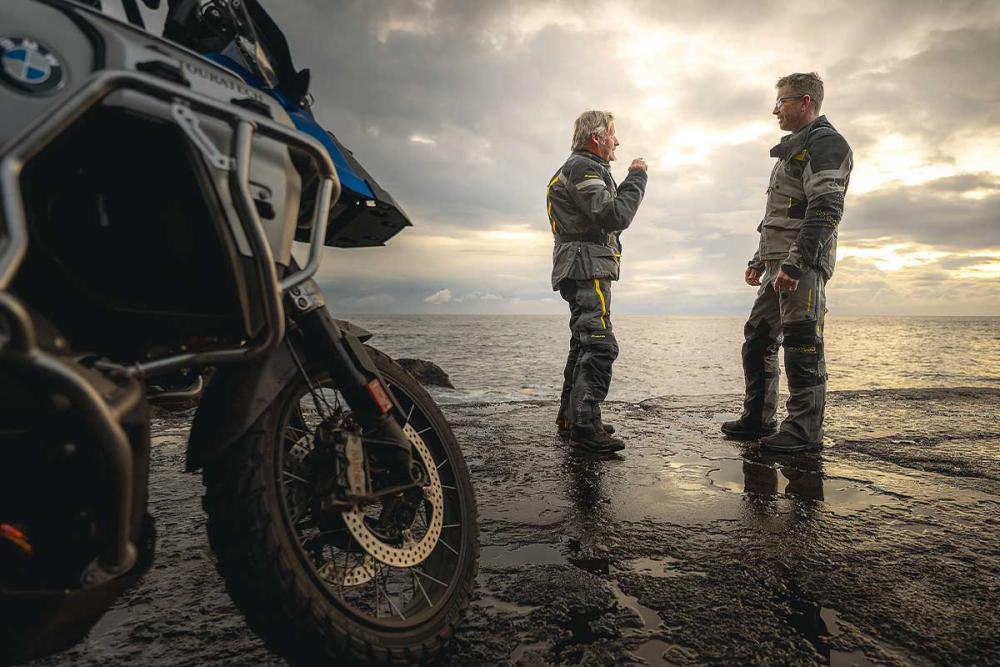
Small talk on one of the many piers.
PAUL GUILLIEN
Paul Guillien is CEO of Touratech USA and a well-known face in the US adventure bike scene. Paul has been instrumental in making the Touratech Rally the largest gathering of adventure riders in the US over the past decade and a half. The event offers incredible riding opportunities, knowledge sharing and entertainment all about being on the road on a motorbike. Paul is also the co-founder of Backcountry Discovery Routes (BDR), which opens up adventurous routes through the backcountry of numerous US states for travelling adventurers.
TRAVEL INFORMATION
GENERAL
The Azores are an archipelago of nine islands in the middle of the Atlantic Ocean, an autonomous territory of Portugal. The Azores are located 1,400 kilometres west of Lisbon and a good 1,900 kilometres south-east of Newfoundland. The climate on the islands is mild all year round. The maximum daily temperatures vary between 16° and 25° C depending on the time of year.
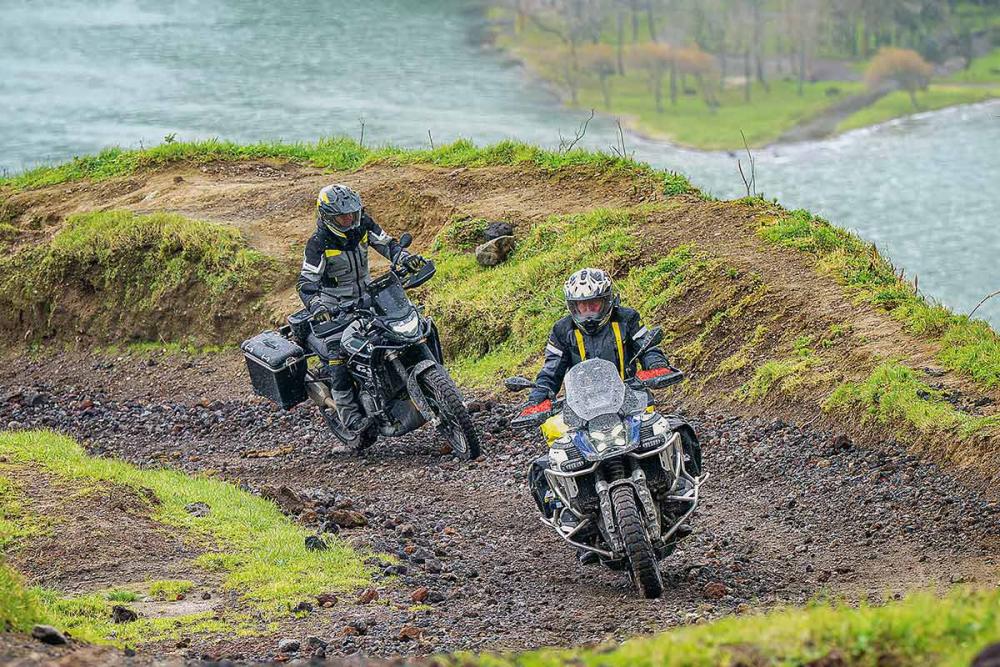
The most important economic sectors are agriculture, dairy farming, livestock farming, fishing and tourism. The islands are of volcanic origin and lie at the intersection of three of the world's most important tectonic plates. The islands have dramatic coastal landscapes and impressive volcanoes, some of which are still active. The vegetation is lush and green, and the weather is mostly humid and cloudy. When the sun emerges from the clouds, the colours of the islands and their waters are breath-taking.
ARRIVAL
Major European cities such as London, Paris, Frankfurt, Barcelona and Amsterdam offer direct flights to the Azores. From the USA, there are direct flights from Boston, New York and Oakland. Although each island has an airport for inter-island travel, the only airports that have a connection to the outside world are João Paulo II (on São Miguel Island), followed by Lajes Airport (Terceira Island) and Horta Airport (Faial Island). There are seasonal ferries between some of the islands, but not between all of them. We stayed on São Miguel for our adventure.
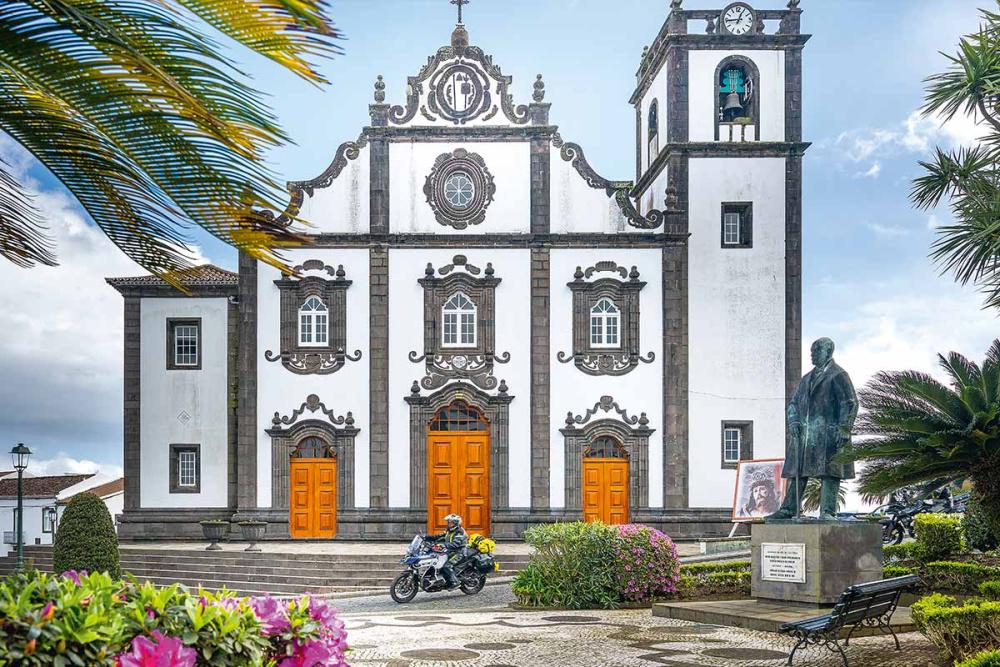
Picturesque baroque church.
MOTORCYCLING
You can hire cars and motorbikes on Saõ Miguel. You can ship your own motorbike to Saõ Miguel with transport companies. Touratech Portugal organises adventure rally events on the island, which include accommodation and shipping of motorbikes (from Lisbon) as well as organised rides and incredible island cuisine.
FOOD
It would be hard to find a place where the seafood is fresher and more delicious. The richness of the sea dominates most restaurant menus. The thriving dairy industry produces award-winning cheeses, while the incredible steaks from the local Ramo Grande beef are another delicacy. The region is also known for growing pineapples, oranges, bananas, taro and sweet potatoes. Bars, restaurants and cafés are plentiful. Finding a hotel is not difficult either.
Text: Paul Guillien, Photos: Mathias Wolpert












